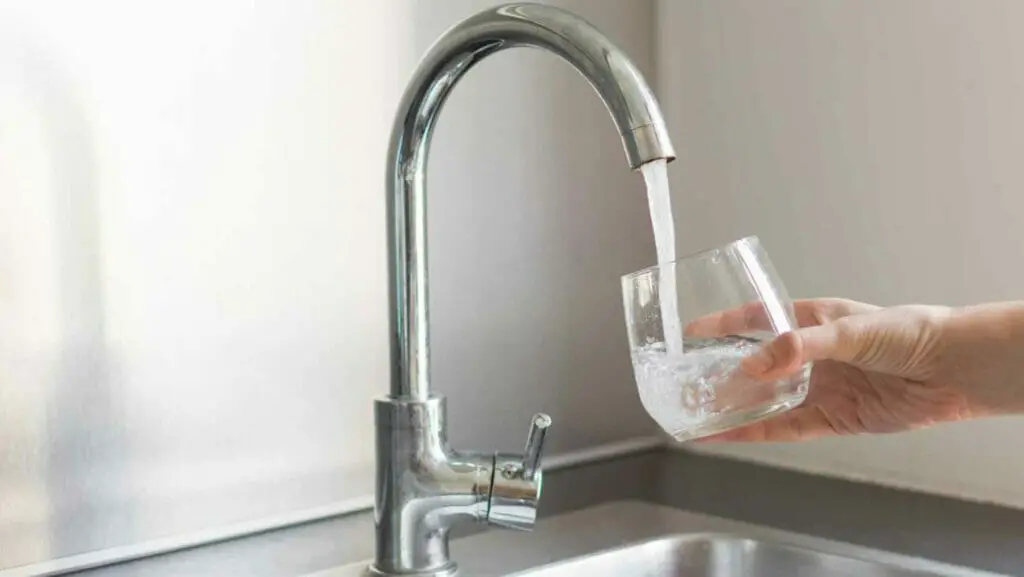
Have you ever turned on your hot water tap only to see cloudy water pouring out? It may be alarming at first, but there are several possible causes for cloudy hot tap water.
Key causes for cloudy hot tap water:
- Air bubbles trapped in the water
- Under pressure within plumbing fixtures
- Harmless and eventually rise to the top and dissipate
- Test by filling a clear glass with hot tap water and observe if cloudiness clears from the bottom up
- Solution: Cloudy-looking air bubbles are harmless and will eventually rise to the top and dissipate
- Sediment or hard water
- Contains higher levels of minerals like calcium and magnesium
- Accumulates in the water heater or plumbing system
- Can cause hot water to look cloudy as it comes in contact with minerals
- Solution: install a water softener or water filtration system, flush water heater regularly, or soak a clogged aerator in white vinegar to clear any sediment hindering the water flow
Below we’ll explore in-depth the main reasons behind cloudy hot water and provide hints and tips on how to fix it for clearer, cleaner water in your home.
Causes of Cloudy Hot Tap Water
Cloudy hot water can be a cause for concern, and understanding the reason behind it can help you take appropriate measures to fix the issue.
Air Bubbles
Your cloudy water may be due to tiny air bubbles trapped inside. When you turn on your hot water tap, pressurized air in the plumbing fixtures release these bubbles, causing the water to look cloudy, but this is not a health risk. Air bubbles are a natural result of hydrogen and oxygen in the water coming in contact with one another.
A simple test to check for air bubbles is to fill up a clear glass with your cloudy water and observe it. If the water clears from the bottom to the top, you can be sure air bubbles are the cause. The cloudiness will dissipate after a couple of minutes as the air rises to the top and escapes.
Mineral Content
Cloudy hot water may also result from high mineral content in the water supply, mainly calcium, and magnesium. This situation is often referred to as hard water. A water softener can help to reduce these minerals, and installing a water filter can help to provide clearer water for your household.
If you’re experiencing cloudy tap water, check with your water supplier to find out if hard water is common in your area. Installing a water softener or a water filtration system can help to resolve this issue and improve the overall water quality in your home.
Water Heater Troubles
Problems with your hot water heater might be contributing to the cloudiness in your tap water. Sediment can accumulate at the bottom of your water heater, affecting the water’s clarity. Flushing your water heater regularly can prevent sediment buildup and improve your water quality.
If you’re unsure how to flush your water heater, a plumber can assist you with this task, ensuring your system is functioning efficiently and providing clear hot water.
Pipe Corrosion
Over time, pipes can corrode, leading to sediment and rust entering your water supply. This can cause a cloudy or milky appearance in your water. Replacing old pipes with newer, corrosion-resistant materials can help to resolve this issue.
If you suspect pipe corrosion is causing your cloudy water, consult a plumber to inspect your pipes and recommend any necessary replacements.
Water Pressure Issues
High water pressure can sometimes lead to cloudy water. Excessive pressure in your water system may cause air bubbles to form and result in cloudiness. Adjusting your water pressure with the help of a plumber can provide a solution in these cases.
Keep in mind that understanding the root cause of your cloudy hot tap water is crucial to implementing the right solution. Be sure to consult a professional plumber if you’re ever unsure about the required steps to ensure safe drinking water for you and your family.
How to Identify the Cause
Cloudy hot tap water can be frustrating, but fear not! There are ways to identify and fix cloudy hot water problems. In this section, we will discuss how to conduct a visual inspection, perform a cold water test, check your water heater, and when to seek professional help.
Conducting a Visual Inspection
First, always start with a visual inspection. Fill a clear glass with hot water from your faucet and observe the water. Tiny air bubbles might cause cloudiness, which will rise to the top and clear from the bottom. However, if you notice sediment at the bottom, this may be a sign of something else, such as hard water or an issue with your water heater.
You can also check your faucet’s aerator (the screen at the end of the faucet) for clogs or sediment buildup. Unscrew it and soak the aerator in white vinegar for a couple of minutes to dissolve any buildup. If the clog persists, consider replacing the aerator.
Performing a Cold Water Test
To better understand the issue, perform a cold water test. Fill a clear glass with cold water from the same faucet and compare it to the hot water. If both the hot and cold water is cloudy, this could indicate a problem with your overall water system, such as high water pressure or common cause issues with your water supplier. However, if only the hot water is cloudy, the issue likely lies within your water heater.
Checking Your Water Heater
Inspect your water heater for any visible issues, such as leaks or corrosion. Additionally, water heaters can accumulate sediment at the bottom of the tank, which may cause cloudy hot water. To resolve this, you can flush your water heater. Connect a hose to the drain valve and empty the tank into a safe location. Remember to switch off the power supply and follow the manufacturer’s instructions for proper flushing procedures.
If your hot water remains cloudy after flushing, it might be time to consult a professional plumber or consider installing a water softener or water filtration system.
Seeking Professional Help
If none of the previous steps helped you identify the cause of your cloudy hot tap water, seeking professional help is the next step. A licensed plumber can perform a thorough inspection of your plumbing fixtures and system to identify the root cause. In some cases, a water softener or filtration system may be needed to address the issue.
Solutions for Clearing Cloudy Hot Tap Water

In this section, we will explore various solutions to help you fix cloudy hot tap water in your home. Let’s dive into the different methods you can try:
Addressing Air Bubbles
A common cause for cloudy hot water is the presence of tiny air bubbles. As air is lighter than water, these bubbles rise to the top and may cause the cloudiness you see in your glass.
To tackle this issue, try turning on your faucets slowly, which will reduce the amount of pressurized air and potentially prevent cloudy water. Additionally, give the glass of water a couple of minutes to settle. If the water starts to clear from the bottom up, it’s a sign that it’s just air bubbles dissipating.
Water Softening and Filtration
Hard water, containing minerals like calcium and magnesium, is another reason for cloudy tap water. You can address this by installing a water softener, which will help reduce the mineral content in your water supply. For clearer water, you can also consider adding a water filtration system to remove sediment and other impurities, thereby improving the quality of your drinking water.
Water Heater Maintenance
Regular maintenance of your hot water heater is essential to prolong its lifespan and ensure that sediment does not build up at the bottom of the tank. Flushing your water heater at least once a year will help prevent sediment accumulation, which is a common cause of cloudy hot water.
To do this, turn off the water heater and open the drain valve, allowing the water to flush out any sediment at the bottom. Consult your water heater’s manual for specific instructions on this process.
Replacing Corroded Pipes
Over time, your home’s plumbing fixtures and pipes can corrode, leading to cloudy hot water. If the steps above don’t fix the problem, it may be time to contact a plumber to inspect your pipes and replace any corroded or damaged sections. This will help restore the clarity of your tap water and improve the overall water system in your home.
Adjusting Water Pressure
High water pressure can cause cloudy or milky water due to increased air bubbles. If you want to reduce water cloudiness, adjusting your water pressure to a lower level may help. Make sure to consult with a plumber or check your water supplier’s guidelines for the appropriate pressure levels for your home.
Prevention Tips
Below, we’ll provide some prevention tips to help you fix cloudy hot water and maintain your plumbing fixtures. We’ll discuss regular maintenance, early detection of issues, and water quality monitoring.
Regular Maintenance
One of the best ways to prevent cloudy hot water is to perform regular maintenance on your water heater and plumbing system. Here are a few tasks you can do:
- Flush your water heater at least once a year to remove sediment buildup at the bottom of the tank.
- Clean or replace your faucet aerators every six months. Soak them in a solution of equal parts water and white vinegar for a couple of minutes, then rinse and reassemble.
- If you have hard water, consider installing a water softener to reduce the amount of calcium and magnesium in your water supply.
Early Detection of Issues
Cloudy hot water can be a sign of an underlying issue, so it’s crucial to detect problems early. Pay attention to the following signs:
- If your water has an unusual smell, taste, or change in tint, it could indicate a problem with your water supply or plumbing system.
- Keep an eye out for reduced water pressure or fluctuations in temperature, as these may be linked to sediment buildup or valve issues.
If you notice any of these signs, it’s best to consult a professional plumber to diagnose and fix the problem.
Water Quality Monitoring
You can improve your tap water quality by conducting regular water quality monitoring. Here’s how:
- Invest in a water filtration system or water filter for your tap to remove contaminants and improve the taste and clarity of your water.
- Check your water supplier’s annual water quality report to learn more about the municipal water’s safety and potential hard water issues.
- Perform at-home water tests to detect hardness levels and other contaminants in your water, helping you identify whether a water softener or filter may be needed.
By following these prevention tips, you’ll be well on your way to enjoying clear and healthy hot tap water. And remember: if your cloudy tap water persists or you have concerns about your water’s safety, don’t hesitate to reach out to a plumber for expert advice.

